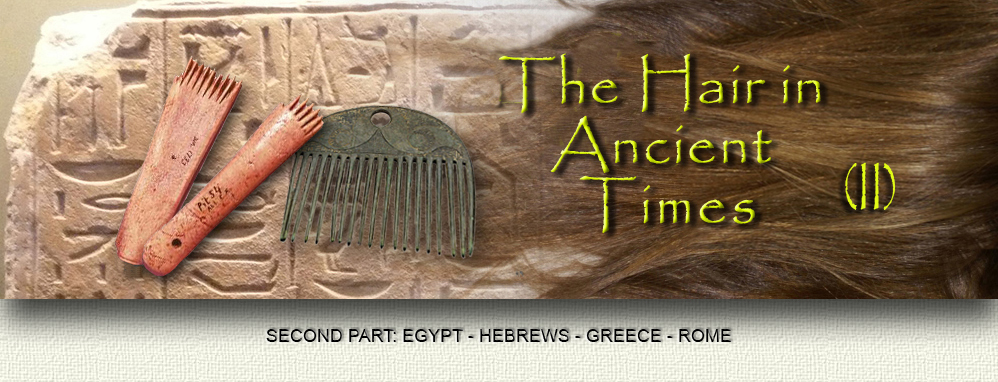
Ginger, the most ancient naturally mummified body known until the present day in Egypt, was blond, with wavy hair and white-yellowish skin. He was found at the cemetery of Gebelein, in South Thebes, in 1900 and it was established that the body is 3,500 years before the Christian Age old, meaning, a 5,500 years old mummy, from the Late Pre-Dynastic period age. His nickname is due to the color and curls of his hair, which is pretty well conserved. He probably was a member of the Naqada Culture's people, which lived before the first pharaohs, and which inhabitants, as all of the Pre-Dynastic period, were of Caucasoid appearance, with dark, reddish or clear brown hair, or blonds, and some of them red-heads; most of them of straight or wavy hair.
Due to the huge number of mummified bodies found in the dry sands close to the Nile Valley, a lot of details about the physical appearance and the social life of ancient Egyptians could be known, especially for the analysis of the bodies' hair.
Joann Fletcher, British Egyptologist and specialist in hair analysis, says that in archaeological researches "Hair is invaluable in the study of general day-to-day living conditions, as well as supplying information on diet and disease". "The most common hair color then, as now, was a very dark brown, almost black color, although natural auburn and even (rather surprisingly) blond hair are also to be found. With their great fondness for elaboration, the Egyptians’ skillful use of dyes has produced yet further shades for us to study, analysis showing many to be various forms of henna, which even an aged Ramses II had used regularly to rejuvenate his white hair."..."As the ancient nits on their tiny-toothed combs will attest, real Egyptians were plagued by infestations of scalp-biting bugs. Real Egyptians cropped their curls and even shaved their heads for the sake of hygiene: specifically, to remove the habitat of lice. And quite clearly, they also loved elaborate hairstyles, and went to great lengths to adorn themselves with wigs, false braids and hair extensions.”"..."Close inspection revealed that the natural hair (from the grave of a woman), of slightly more than shoulder-length, had been augmented with a considerable number of artificial lengths of false hair, very reminiscent of modern dreadlocks, meticulously worked into the natural hair to create an imposing high coiffure. The complex styling techniques made it clear that her particular hairstyle was the result of many hours of careful work carried out by someone other than herself."..."In depth examination showed a contrast between the auburn cast of her dark brown hair and a smaller number of unpigmented white strands of hair associated with the aging process. The unpigmented hair had been turned the bright orange color typical of henna"... |
Egyptians used their hair in different ways: they could have, -men and women- clean shaven heads, or to use the hair shoulder-length, or cut short up to the nape. Hairstyles for them did not determine the gender. However, it could be a sign of the age or the social group. Children were generally shaved-off until the puberty, and after that age, they could decide whether to use short or long hair. Old people used wigs to hide their baldness or their white hair. Workmen wore their hair cut short, usually with a bang. Between the most powerful social classes, it was frequent the use of wigs and elaborated extensions, with the assistance of personal hair dressers and wig makers.
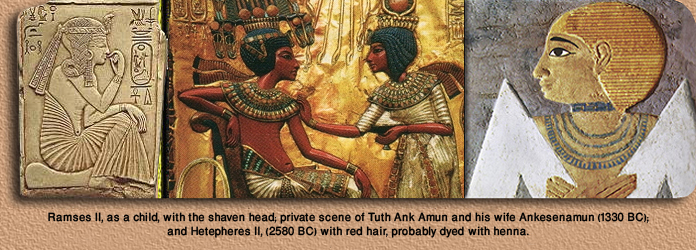
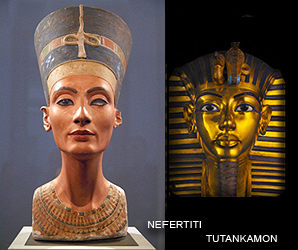 As we can see in the image above, hairs in the middle picture are black and curly, and both figures show a darker skin color. Near 3200 BC the kingdoms of Upper and Lower Egypt were still separated, and after the unification, it will begin the Dynastic period of pharaohs. When the Empire is expanded, African ethnic groups were introduced in the country, and along the centuries, they will be blended with Pre-Dynastic period first inhabitants. At the times of Akhenaton, his wife Nefertiti and his son Tuthankamun, -14th century BC- images with figures typically negroids could be observed: thicker leaps, darker color of skin and curly black hair. However, an analysis of the mummy of Ramses II, a body 87 years old at the time he dead, reveals in the follicle roots red pigments, which means that he would have been a red-head, with white hair at that age, and colored with henna. In addition, the roots of the hair of Ramses have circular follicles oblique positioned, which indicates a wavy hair, of leucodermic characteristics (white skin). At the beginning of the Dynastic period (near 3000 BC), heads were worn clean shaven or cut short: it helped the capillary hygiene, but to avoid the exposition to the sun, they covered their heads with wigs. Wigs were made of human hair or the wool of black sheep. With exception of the Early Kingdom period (2705 to 2213 BC), men used to shave-off their whole face. Only in this period could be found images depicting thin moustaches.
As we can see in the image above, hairs in the middle picture are black and curly, and both figures show a darker skin color. Near 3200 BC the kingdoms of Upper and Lower Egypt were still separated, and after the unification, it will begin the Dynastic period of pharaohs. When the Empire is expanded, African ethnic groups were introduced in the country, and along the centuries, they will be blended with Pre-Dynastic period first inhabitants. At the times of Akhenaton, his wife Nefertiti and his son Tuthankamun, -14th century BC- images with figures typically negroids could be observed: thicker leaps, darker color of skin and curly black hair. However, an analysis of the mummy of Ramses II, a body 87 years old at the time he dead, reveals in the follicle roots red pigments, which means that he would have been a red-head, with white hair at that age, and colored with henna. In addition, the roots of the hair of Ramses have circular follicles oblique positioned, which indicates a wavy hair, of leucodermic characteristics (white skin). At the beginning of the Dynastic period (near 3000 BC), heads were worn clean shaven or cut short: it helped the capillary hygiene, but to avoid the exposition to the sun, they covered their heads with wigs. Wigs were made of human hair or the wool of black sheep. With exception of the Early Kingdom period (2705 to 2213 BC), men used to shave-off their whole face. Only in this period could be found images depicting thin moustaches.
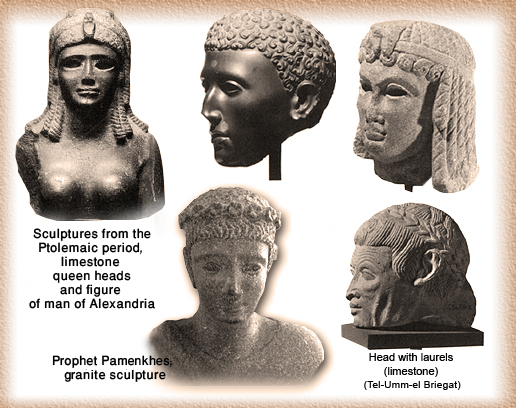 During the Late Pre-Dynastic period, from 305 BC to 30 BC, when the Ptolomies ruled in Egypt, an important change in hairstyle could be observed. Ptolomies were Macedonians, of Hellenistic culture, and after the death of Alexander the Great they started to conquer all the Nile Valley. The Ptolemaic Dynasty ended with their last queen, Cleopatra VII, when Egypt was annexed to the Roman Empire. At this time the hairstyles show the Greek style: short and wavy hair, in a natural way, with less use of wigs and extensions. Wigs also had wavy hairs. They also wore laurels and bands. In this period Greek and Egyptian styles are mixed, in all their possibilities.
During the Late Pre-Dynastic period, from 305 BC to 30 BC, when the Ptolomies ruled in Egypt, an important change in hairstyle could be observed. Ptolomies were Macedonians, of Hellenistic culture, and after the death of Alexander the Great they started to conquer all the Nile Valley. The Ptolemaic Dynasty ended with their last queen, Cleopatra VII, when Egypt was annexed to the Roman Empire. At this time the hairstyles show the Greek style: short and wavy hair, in a natural way, with less use of wigs and extensions. Wigs also had wavy hairs. They also wore laurels and bands. In this period Greek and Egyptian styles are mixed, in all their possibilities.
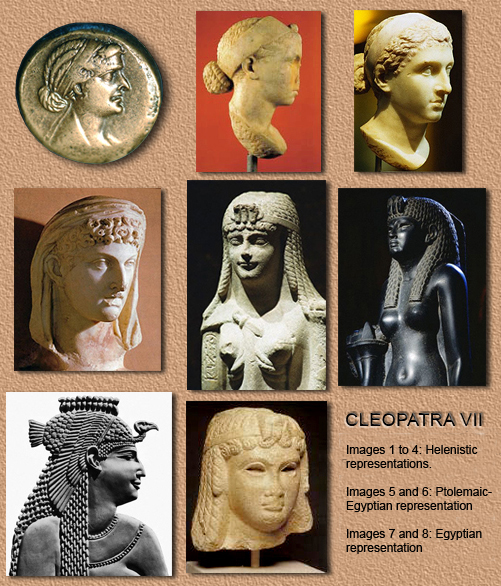
Cleopatra VII, the last Ptolemaic queen, who ruled from 51 BC until 30 BC, wore different hairstyles, according with different situations. She was of Greek blood, Macedonian, not having any Egyptian appearance. In her visits to Rome, she used the classic Greek style, which was the one which really matched with her Hellenistic look, with a headwear called "melon hairstyle", as seen in many Greek sculptures; the hair pulled back in waves, tied in the nape with a chignon. When she was in the court of Alexandria, she used an Egyptian-Ptolomaic hairstyle, a blend of Greek and Egyptian features, being a characteristic style of this period. And when she gave speeches to her people, her look and hairstyle were typically pure Egyptian: the hair is segmented in three sections and an image of a cobra is used as a crown.
PRODUCTS USED IN HAIR TREATMENT IN OLD EGYPT:
WASHING:
Ancient Egyptians used to wash their hair and their wigs regularly. They have a way to do it with a mix of water and citric juices. The citric acid dissolves the fatty oils from the hair and leaves the follicle sealed, so it keeps it dry. The hair results smooth and brilliant. They used almond oil as a conditioner after washing the head.
DEPILATION:
Methods of hair removal included preparations like a paste made of lime, starch and arsenic. They also used a mix of sugar and beeswax to remove superfluous hair. They had razors made of copper or bronze with sharp edges, and efficient tweezers.
 COLORATION:
COLORATION:
Along the centuries, their favorite colors were black or orange-reds. Since 4,000 years before the Christian Age, the henna was the most common dye; it gives orange or red variations to the hair color. They mixed it with cow's blood and crushed tadpoles, to obtain different tonalities. The henna plant (lawsonia inermis) grew abundantly in the banks of the River Nile. To make black dyes they used the indigo, extracted from the plant indigofera tinctoria. Those who became gray-haired colored their hair with a recipe of blood of ox boiled in oil: it was a magic solution, because it was believed that the darkness of the animal was transferred to the hair. After 1500 BC they started to use wigs of vivid colors, like blue, red or green.
TREATMENT FOR BALDNESS:
As it always has been, those who became bald because they lose their hair, were not happy and they wanted to recover it. The recipes were based in several preparations, with fat of different animals: goats, lions, crocodiles, snakes and hippopotamus, and also cats. Another cure was a patch made with leaves of lettuce, or the application of fenugreek’s seeds.
FIXATIVES:
To set their hairstyles, they applied an ointment of beeswax, letting it dry exposing the head to the sun, until it hardened.
HAIR GROWING STIMULATION :
Different oils were used to strengthen the hair: almond oil, rosemary oil, or castor oil.
ANCIENT HEBREWS
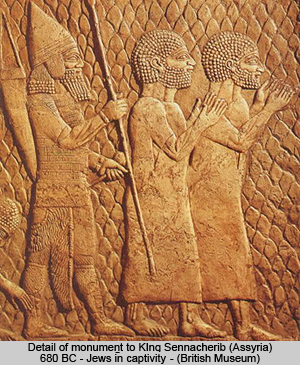 According with the Hebrew Bible, the ancient Hebrews come from the southeastern Mesopotamia, which was the ancient Chaldea, settling in the Land of Canaan -today Israel and Palestine-, about 4,000 years ago. As a people of Chaldean origin, their appearance must have been similar to the Semitic tribes of the region. Hebrews did not leave neither bas reliefs nor statuettes representing their physiognomy, but the Hebrew characteristics are described in theTorah, and, in Egyptian and Assyrian monuments their images are still conserved. With these references it's easy to realize that they had dark skin with melanodermic characteristics, which means elliptical capillary follicles, almost parallel to the skin, what produce very curly hair and a high concentration of melanin, that is to say, black hair. In The Song of Songs, credited to king Solomon (1001-976 BC), -Chap. V, 11-, the Shulamite says that the hair of her beloved is black as "the wings of a crow ", and curly. In reference to the hair of the Shulamite, it says they are "black like a flock of goats ". They wore long hair, thick and curly. The Mosaic law commanded nothing respecting the mode of wearing the hair. Priests had theirs cut every fortnight. They were forbidden to shave their heads in honor of the gods, as the ancient nations used to do, but they used to cut off the hair as a signal of mourning, or as a way to demonstrate affliction or humiliation for sin. In the Deuteronomy, (14:1) is stated: " ...Ye shall not cut yourselves, nor make any baldness between your eyes for the dead
According with the Hebrew Bible, the ancient Hebrews come from the southeastern Mesopotamia, which was the ancient Chaldea, settling in the Land of Canaan -today Israel and Palestine-, about 4,000 years ago. As a people of Chaldean origin, their appearance must have been similar to the Semitic tribes of the region. Hebrews did not leave neither bas reliefs nor statuettes representing their physiognomy, but the Hebrew characteristics are described in theTorah, and, in Egyptian and Assyrian monuments their images are still conserved. With these references it's easy to realize that they had dark skin with melanodermic characteristics, which means elliptical capillary follicles, almost parallel to the skin, what produce very curly hair and a high concentration of melanin, that is to say, black hair. In The Song of Songs, credited to king Solomon (1001-976 BC), -Chap. V, 11-, the Shulamite says that the hair of her beloved is black as "the wings of a crow ", and curly. In reference to the hair of the Shulamite, it says they are "black like a flock of goats ". They wore long hair, thick and curly. The Mosaic law commanded nothing respecting the mode of wearing the hair. Priests had theirs cut every fortnight. They were forbidden to shave their heads in honor of the gods, as the ancient nations used to do, but they used to cut off the hair as a signal of mourning, or as a way to demonstrate affliction or humiliation for sin. In the Deuteronomy, (14:1) is stated: " ...Ye shall not cut yourselves, nor make any baldness between your eyes for the dead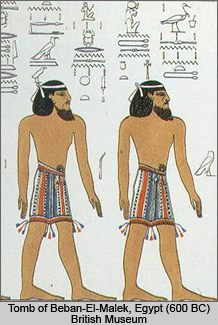 ". Nazarites were never to cut off their hair, at the way of Samson. In Leviticus (19:27) is written: "Ye shall not round the corners of your heads, neither shalt thou mar the corners of thy beard". Among the Hebrews, baldness was considered not only a defect, but also a curse. "And shame shall be upon all faces, and baldness upon all their heads " (Ezekiel, 7:18). In the time of King David, the hair was a valuable ornament, and the longer it was, the more it was esteemed. They used to powder their hair with dust of gold; Flavius Josephus (38-101), the Roman-Jewish historian, tells us in his "Antiquities of the Jews" that Solomon and their guard, with long flowing hair on their shoulders, scattered in their hair, daily, small particles of gold, which made it shine and sparkle by the reflection of the rays of the sun upon it. Hebrews used to anoint their hair with several kinds of oils. They also used perfumed oils, which they used to spill on the heads of their visitors, as a welcome signal. "Thou preparest a table before me in the presence of mine enemies: thou anointest my head with oil; my cup runneth over" (Psalms, 23:5). The Jews, today, show strong differences with the ancient Hebrews. After the Diaspora (dispersion for the world in the year 70 due to a conflict with the Roman Empire) they were mixed with other populations of Central Europe (Ashkenazi Jews) and North Africa and Spain (Sephardi Jews). Today we can see red head jews, or with blond, brown or black hair. The Beta Israel Jews (Falashas), are black Jews who live in Ethiopia, and they consider themselves as the authentic descendants of the ancient Hebrews.
". Nazarites were never to cut off their hair, at the way of Samson. In Leviticus (19:27) is written: "Ye shall not round the corners of your heads, neither shalt thou mar the corners of thy beard". Among the Hebrews, baldness was considered not only a defect, but also a curse. "And shame shall be upon all faces, and baldness upon all their heads " (Ezekiel, 7:18). In the time of King David, the hair was a valuable ornament, and the longer it was, the more it was esteemed. They used to powder their hair with dust of gold; Flavius Josephus (38-101), the Roman-Jewish historian, tells us in his "Antiquities of the Jews" that Solomon and their guard, with long flowing hair on their shoulders, scattered in their hair, daily, small particles of gold, which made it shine and sparkle by the reflection of the rays of the sun upon it. Hebrews used to anoint their hair with several kinds of oils. They also used perfumed oils, which they used to spill on the heads of their visitors, as a welcome signal. "Thou preparest a table before me in the presence of mine enemies: thou anointest my head with oil; my cup runneth over" (Psalms, 23:5). The Jews, today, show strong differences with the ancient Hebrews. After the Diaspora (dispersion for the world in the year 70 due to a conflict with the Roman Empire) they were mixed with other populations of Central Europe (Ashkenazi Jews) and North Africa and Spain (Sephardi Jews). Today we can see red head jews, or with blond, brown or black hair. The Beta Israel Jews (Falashas), are black Jews who live in Ethiopia, and they consider themselves as the authentic descendants of the ancient Hebrews.
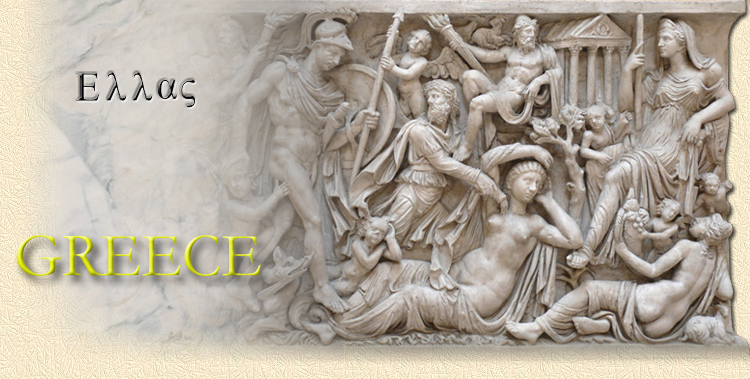
Ancient Greece imposed its hairstyle to the entire world known at that time.
It was the extraordinary Greek civilization which, with its natural and simple hairstyles moving in harmonious waves, marked the hairstyle of the Ancient world. All the neighbor countries and the others conquered by them, will adopt, in one or another moment, its particular style, which later will be inherited by the Roman Empire. The Ancient Greece was the base and the fundamental pillar of al the Occidental culture. Its costumes, architecture, philosophy, and mythological traditions were inherited by the posterior centuries and were present in the Renaissance and in the 18th and 19th centuries.
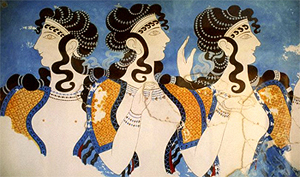 The most ancient Greek civilization was the Minoic civilization of the Island of Crete, which existed from the year 7.000 BC until the year 1600 BC. In this year they were invaded by the Indo-Europeans from the North West, who founded the Micenic civilization. Through the testimonies of vases and mural paintings we know that the people of these periods were of white skin, with black hair in the Minoic civilization and blond hair in the Micenic civilization. Micenics were called
The most ancient Greek civilization was the Minoic civilization of the Island of Crete, which existed from the year 7.000 BC until the year 1600 BC. In this year they were invaded by the Indo-Europeans from the North West, who founded the Micenic civilization. Through the testimonies of vases and mural paintings we know that the people of these periods were of white skin, with black hair in the Minoic civilization and blond hair in the Micenic civilization. Micenics were called 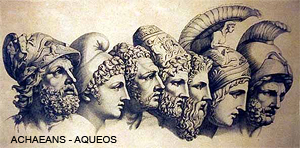 “Achaeans” by Homer in The Iliad. Men used natural hair, wavy and beards. The Trojans, who inhabited what today is Anatolia en Turkey, had black hair, and their women’s hairstyles were carefully elaborated. Married women used long hair with long braids, as a sign of their marital status. In this mural painting, "The Blue Ladies", from 1.600 BC are notorious these hairstyles.
“Achaeans” by Homer in The Iliad. Men used natural hair, wavy and beards. The Trojans, who inhabited what today is Anatolia en Turkey, had black hair, and their women’s hairstyles were carefully elaborated. Married women used long hair with long braids, as a sign of their marital status. In this mural painting, "The Blue Ladies", from 1.600 BC are notorious these hairstyles.
This hairstyle with long hair and braids is also found in all the representations of goddesses, like Athena, Artemisia, Aphrodite o Cassandra.
There are no representations of blonde goddesses; however, several male gods have been represented or mentioned with "golden hair", which is a clue to assume that blond hair was the desired hair color for the Greeks.
The cut and style was also a sign of social status: slaves used shorn heads, and people of higher classes elaborated hair dressings, perfumed with olive oil and scented with fragrances; though, in general, the Greeks’ hairstyles were pretty natural.
Near the 5th century BC, in the Classic Greece period, women already used quite different hairstyles than those of their ancestors of the Minoic civilization. Their hair was long, shoulder-length or over the back, and usually held by a diadem or a band. In this period, women stop to use braids as a symbol of marital status. The bands which adorned their heads were called “estefanias” and some of them were made of gold.
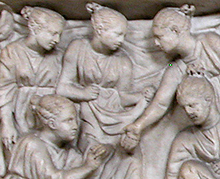
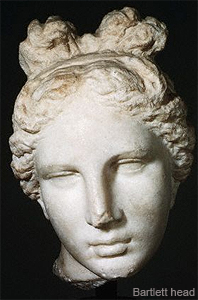 The next splendorous period in Ancient Greece was the Hellenistic Age, which begins at the death of Alexander the Great, in 323 BC. Since that moment may be observed in well conserved images hair artificially waved or curled. In this epoch were used a lot of types of hairstyles, including chignons, braids, bangs, hair tied with tiaras or diadems, and other styles, like the “melon hairstyle", (image at the left) which consisted in to pull the hair backward with a chignon at the back of the head, or a very particular style found in an Aphrodite’s sculpture donated in 1912 to the Boston Museum by Francis Bartlett, dating from the year 330 BC which shows the hair tied with two knots in the top of the head. This sculpture was named “The Bartlett Head", and reveals a hairstyle in fashion at the beginning of the Hellenistic period. Men’s style was also of wavy hair and beards, which were meticulously cut, curled and combed. To that task were barbers dedicated to. The art of cut and grooming beards became an important profession in the Ancient Greece. It was there where the first barbershops were born; they became real meeting points, like clubs, for men in general, where they met and had long conversations about philosophical, political or communal themes. Those barbershops were for them as important as the Agora, their public place of assembly.
The next splendorous period in Ancient Greece was the Hellenistic Age, which begins at the death of Alexander the Great, in 323 BC. Since that moment may be observed in well conserved images hair artificially waved or curled. In this epoch were used a lot of types of hairstyles, including chignons, braids, bangs, hair tied with tiaras or diadems, and other styles, like the “melon hairstyle", (image at the left) which consisted in to pull the hair backward with a chignon at the back of the head, or a very particular style found in an Aphrodite’s sculpture donated in 1912 to the Boston Museum by Francis Bartlett, dating from the year 330 BC which shows the hair tied with two knots in the top of the head. This sculpture was named “The Bartlett Head", and reveals a hairstyle in fashion at the beginning of the Hellenistic period. Men’s style was also of wavy hair and beards, which were meticulously cut, curled and combed. To that task were barbers dedicated to. The art of cut and grooming beards became an important profession in the Ancient Greece. It was there where the first barbershops were born; they became real meeting points, like clubs, for men in general, where they met and had long conversations about philosophical, political or communal themes. Those barbershops were for them as important as the Agora, their public place of assembly.
 |
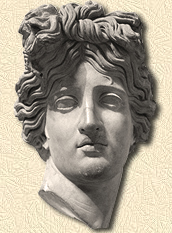 |
 |
 |
| Sophocles | Ancient Greek bust | Alexander the Great | Pericles |
Greeks used to perfume their heads with aromatic scents made from flowers, spices and olive oil. They believed that the scents had been delivered to the world by the gods, and they applied fragrances to their body and their hair. They used to boil a mix of flowers and herbs, like myrrh or frankincense, preparing a recipe with olive oil. To soften the hair, they applied brushing and massages. Also they made the hair brighter with the use of lotions, ointments and beeswax. Most of the population of the Ancient Greece had black hair, and for that reason they used yellow dyes, -which was, undoubtedly, their favorite color-, using a mix of saffron flowers and potassium water (a mix of potassium bicarbonate and carbonic acid water).

The Roman Empire, at the top of its glory, ruled almost all the known world at that time. It was founded, historically, at the year 753 BC by the legendary characters Romulus and Remus and it had 3 periods: The Kingdom, (753 BC-510 BC) the Republic (510 BC-27 BC) and the Empire (from the year 27 BC until the invasion of barbarians at the 4th century). After the fall of the Western Roman Empire, the Eastern Roman Empire, with seat in Constantinople, survived until the 13th century.
Since the most ancient times, Romans gave special importance to their physical appearance and their hair, and, as they became a highly organized society, with a very specific social structure, their dresses and hairstyles marked social status, age, and political and religious beliefs.
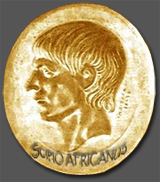 At the Early Kingdom and at the times of the Republic was common in men the use of beards and long hair. At the end of the Republic, approximately in the 3rd century BC, the conquest of Greece brought to Rome a deep influence of all the Greek culture, and even the costume of being clean shaven with the assistance of barbers. At that time the entire world’s culture was centralized in Greece, and even the cultivated elite of Rome studied and spoke in Greek as their academic language. According with Plinius the Elder, the first Roman who showed up clean shaven was the general and consul Scipio Africanus. That’s the way his image is depicted in a coin of the 3rd century. Since that day, it will be the hairstyle of all the Roman men, until the fall of the Empire, when the beards and long hair started to be worn again.
At the Early Kingdom and at the times of the Republic was common in men the use of beards and long hair. At the end of the Republic, approximately in the 3rd century BC, the conquest of Greece brought to Rome a deep influence of all the Greek culture, and even the costume of being clean shaven with the assistance of barbers. At that time the entire world’s culture was centralized in Greece, and even the cultivated elite of Rome studied and spoke in Greek as their academic language. According with Plinius the Elder, the first Roman who showed up clean shaven was the general and consul Scipio Africanus. That’s the way his image is depicted in a coin of the 3rd century. Since that day, it will be the hairstyle of all the Roman men, until the fall of the Empire, when the beards and long hair started to be worn again.
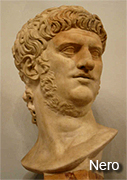 Nero wore the same hairstyle than the chariot racers, because he was a fan of that sport: with curls framing his face and long sideburns.
Nero wore the same hairstyle than the chariot racers, because he was a fan of that sport: with curls framing his face and long sideburns.
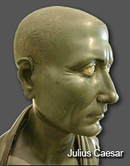 Baldness was bad seen between Romans; it was considered a sign of physical diminution. Caligula was bald, and he wore wigs, crowns of laurels and diadems to hide his condition. Julius Caesar, at contrary, didn’t hide his baldness.
Baldness was bad seen between Romans; it was considered a sign of physical diminution. Caligula was bald, and he wore wigs, crowns of laurels and diadems to hide his condition. Julius Caesar, at contrary, didn’t hide his baldness.
The Greek influence brought also the costume of barbers and barbershops, which in Rome were also interesting places of reunion for men, where, -according with what was found in archaeological excavations-, they were sitting in long benches of wood, playing dices. Those who provided hair care and shaving services were called "tonsors" and the barbershops "tonstrinaes". The "tonsors" also practiced dental extractions already at that time. Shaving of beards was made only with water and razors of bronze, sharpened with stones, ("novaculae") or by means of depilation with beeswax and tweezers. Patricians, people of better social status, had their own barbers and hairdressers amongst their servants.
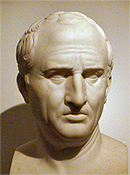 |
"How horrible was his approach, how savage, how terrible was to look at!... You would say that you were beholding one of those bearded men, an example of the Old Empire, an example of antiquity, a prop of the Republic. His garments were rough, made of this purple worn by the common people around us, nearly brown. His hair was so rough that in Capua, in which he, for the sake of becoming entitled to have an image of himself, was exercising the authority of a decemvir, it seems as if he would require the whole Seplasia to make it decent”. (Cicero, Roman consul and constitutionalist (106 AC-43 AC). Speech against Piso, whom he considered a corrupt politician). |
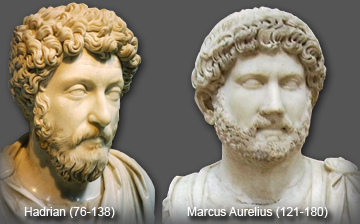 Nevertheless, two centuries later, a trend to a philosophic look of the Emperors put in fashion again the use of beards. In the times of Emperor Hadrian, it was normal to see men with braids in the nape and ponytails. Marcus Aurelius, at his turn, brought up the fashion of long hair, curly and beards. At the end of the Empire, shaven faces and short hair were the style back again, like it used to be in the best times of Cesar and Augustus. The Emperor Constantine the Great, ruler of the Byzantine Empire, always showed his image with a clean shaven face, with no beards, in notorious contrast with the bearded faces of those Barbarians who invaded the Western Roman Empire.
Nevertheless, two centuries later, a trend to a philosophic look of the Emperors put in fashion again the use of beards. In the times of Emperor Hadrian, it was normal to see men with braids in the nape and ponytails. Marcus Aurelius, at his turn, brought up the fashion of long hair, curly and beards. At the end of the Empire, shaven faces and short hair were the style back again, like it used to be in the best times of Cesar and Augustus. The Emperor Constantine the Great, ruler of the Byzantine Empire, always showed his image with a clean shaven face, with no beards, in notorious contrast with the bearded faces of those Barbarians who invaded the Western Roman Empire.
ROMAN WOMEN'S HAIRSTYLE:
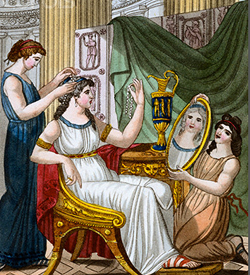 Plinius the Elder used to say: "How tedious and boring is the time dedicated by Roman women to those endless sessions of hairdressing..." Roman Patrician women, who had a better social status, adorned their hair assisted by servants or slaves called "ornatrix", who made their hair ornaments. Complex and sophisticated styles were indicative of a high social status, while the simple ones were considered a sign of barbarism. To curl their hair they use a tool called "calamistrum", (a curling iron) which was a hollow iron tube that was heated on the ashes and the hair was rolled around it. They wore wigs to augment the size of their hair. As some of them were very sophisticated, the Roman poet Juvenal said: "The more important is the matter of their beauty, more stores piled one on each other like a building". The common name among the Romans for a wig, was "Galerus". Wigs were usually made with human hair; blond hair came from German slaves and black hair from India. Dyes were made with different formulas, mixing henna with other herbs for reddish hairs, saffron flowers for blond hair and a weird recipe recommended by Plinius the Elder to dye the hair of black color: "applying leeches that have rotten in red wine for 40 days, and, with the juice obtained of that, to colorize the hair”. They also used potassium water and hydrogen peroxide, or bleach, to decolorize it.
Plinius the Elder used to say: "How tedious and boring is the time dedicated by Roman women to those endless sessions of hairdressing..." Roman Patrician women, who had a better social status, adorned their hair assisted by servants or slaves called "ornatrix", who made their hair ornaments. Complex and sophisticated styles were indicative of a high social status, while the simple ones were considered a sign of barbarism. To curl their hair they use a tool called "calamistrum", (a curling iron) which was a hollow iron tube that was heated on the ashes and the hair was rolled around it. They wore wigs to augment the size of their hair. As some of them were very sophisticated, the Roman poet Juvenal said: "The more important is the matter of their beauty, more stores piled one on each other like a building". The common name among the Romans for a wig, was "Galerus". Wigs were usually made with human hair; blond hair came from German slaves and black hair from India. Dyes were made with different formulas, mixing henna with other herbs for reddish hairs, saffron flowers for blond hair and a weird recipe recommended by Plinius the Elder to dye the hair of black color: "applying leeches that have rotten in red wine for 40 days, and, with the juice obtained of that, to colorize the hair”. They also used potassium water and hydrogen peroxide, or bleach, to decolorize it.
Women hairstyles were changing throughout the years; the "tutulus" hairstyle, inherited from the Etruscans, was the most usual, used by the materfamiliae (mothers of family), and it was used almost all the time in the Ancient Rome. The "nodus" hairstyle, was the hair parted in three, with the hair from the sides of the head tied in a bun at the back while the middle section is tied in a knot at the top of the head. The "sine crine" hairstyle was made with six locks independently braided and was only worn by brides or Vestal virgins. Along the life of the Roman Empire, there were several different hairstyles, as those of we can watch here:
| <The Hair in Ancient Times (I) | Middle Ages - Renaissance > |
| DEUTSCH |
ENGLISH |
ESPAÑOL |
FRANÇAIS |
ITALIANO |
русский |
SRPSKI |
| Start | The Hair | What the hair is | Prehistory | Mythology | Old Age (1st. part) | Old Age (2nd. part) |
| Middle Ages/Renaissance | 18th Century | 19th Century | 20th Century | Barbers' History | The End | Contact |
